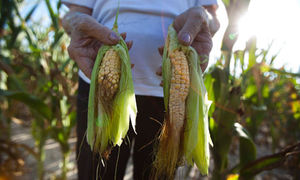

| Visitors Now: | |
| Total Visits: | |
| Total Stories: |

| Story Views | |
| Now: | |
| Last Hour: | |
| Last 24 Hours: | |
| Total: | |
Time Is Running Out: World In Serious Trouble On Food Front

The U.S. is the leading producer and exporter of corn, the world's feedgrain. At home, corn accounts for four-fifths of the U.S. grain harvest. Internationally, the U.S. corn crop exceeds China's rice and wheat harvests combined. Among the big three grains – corn, wheat and rice – corn is now the leader, with production well above that of wheat and nearly double that of rice.
The corn plant is as sensitive as it is productive. Thirsty and fast-growing, it is vulnerable to both extreme heat and drought. At elevated temperatures, the corn plant, which is normally so productive, goes into thermal shock.
As spring turned into summer, the thermometer began to rise across the Corn Belt. In St. Louis, Missouri, in the southern Corn Belt, the temperature in late June and early July climbed to 100 degrees Fahrenheit or higher 10 days in a row. For the past several weeks, the Corn Belt has been blanketed with dehydrating heat.
Weekly drought maps published by the University of Nebraska show the drought-stricken area spreading across more and more of the country until, by mid-July, it engulfed virtually the entire Corn Belt. Soil moisture readings in the Corn Belt are now among the lowest ever recorded.
While temperature, rainfall and drought serve as indirect indicators of crop growing conditions, each week the U.S. Department of Agriculture releases a report on the actual state of the corn crop. This year the early reports were promising. On May 21, 77 percent of the U.S. corn crop was rated as good to excellent. The following week the share of the crop in this category dropped to 72 percent. Over the next eight weeks, it dropped to 26 percent, one of the lowest ratings on record. The other 74 percent is rated very poor to fair. And the crop is still deteriorating.


